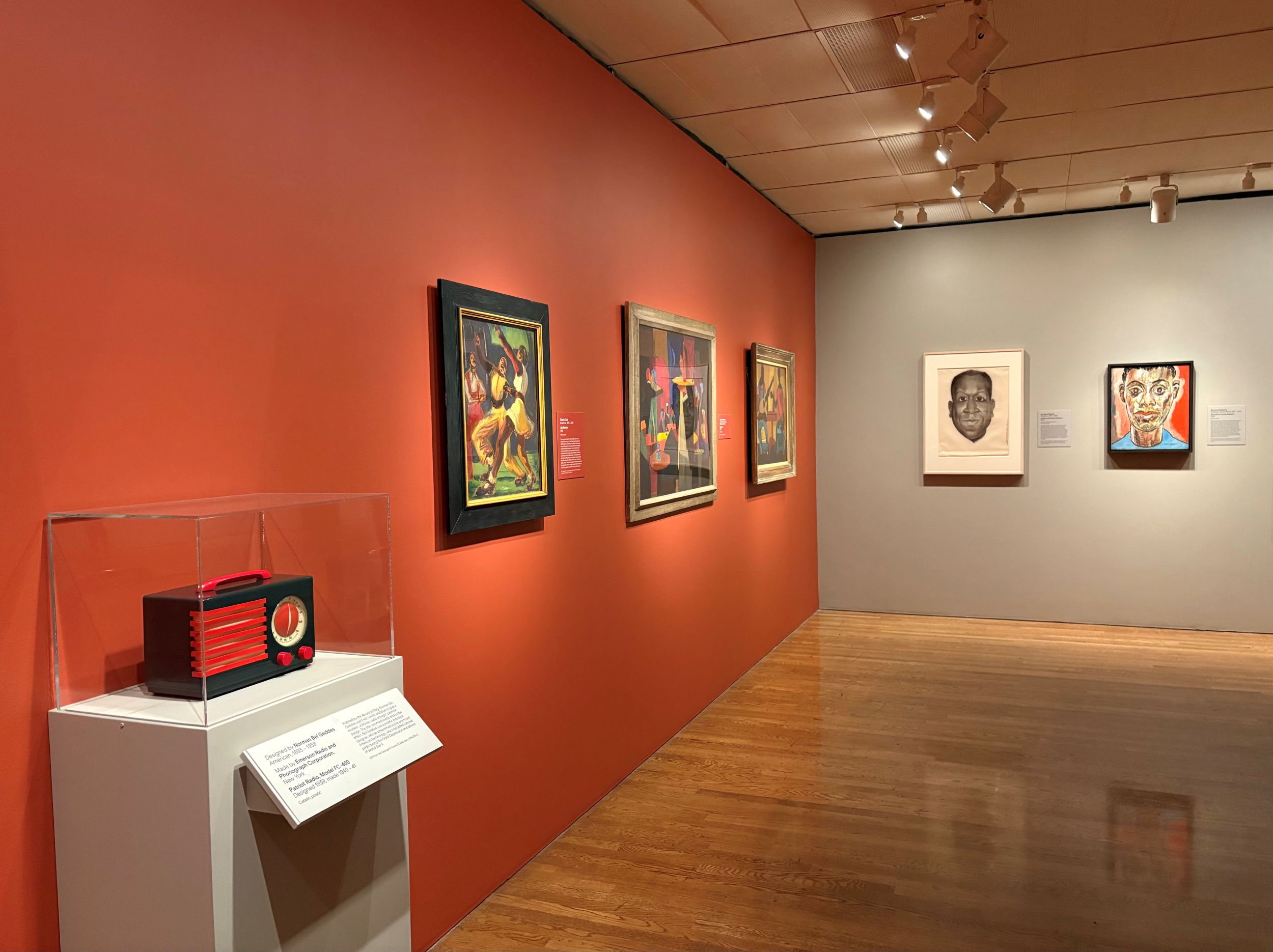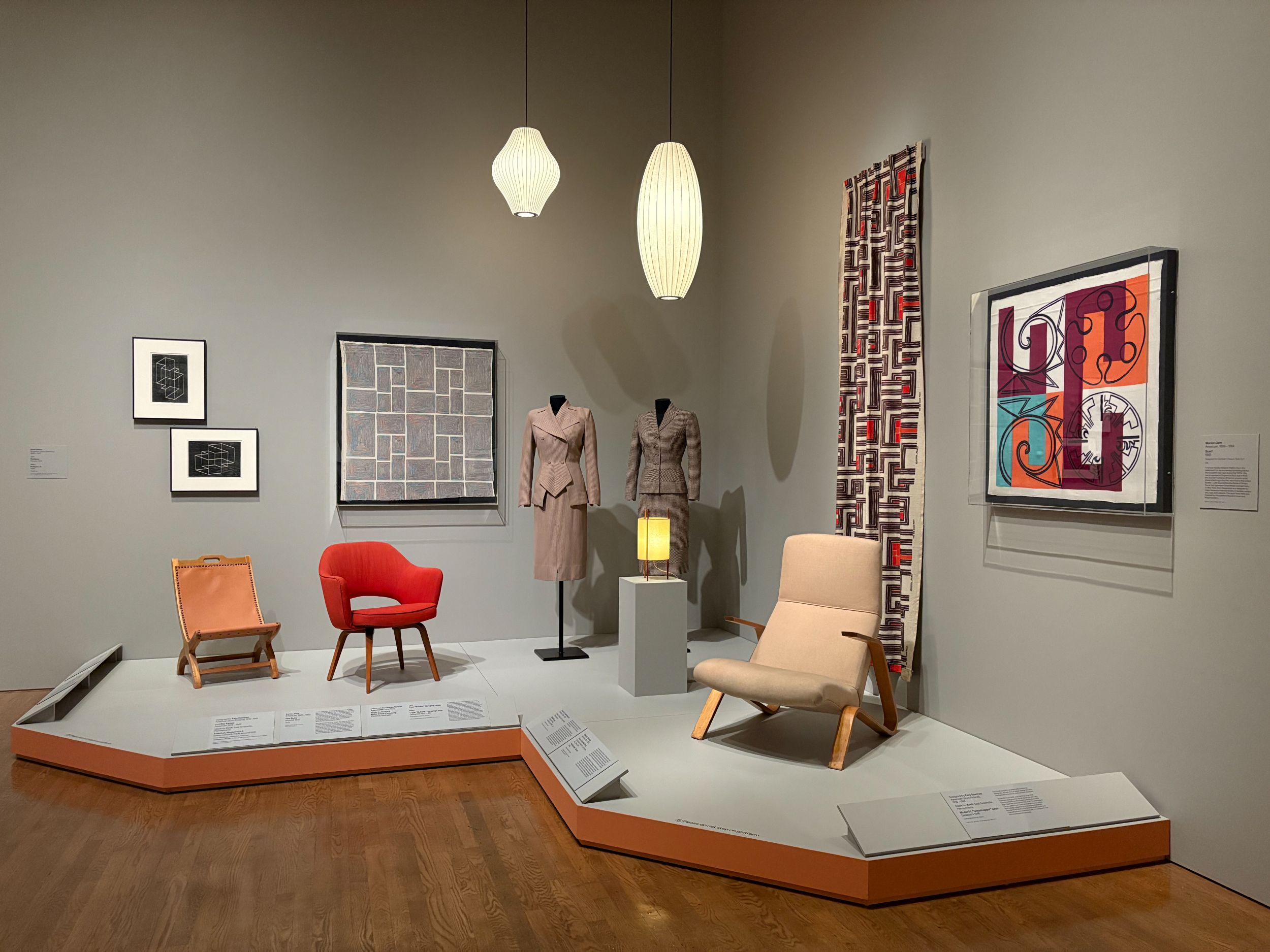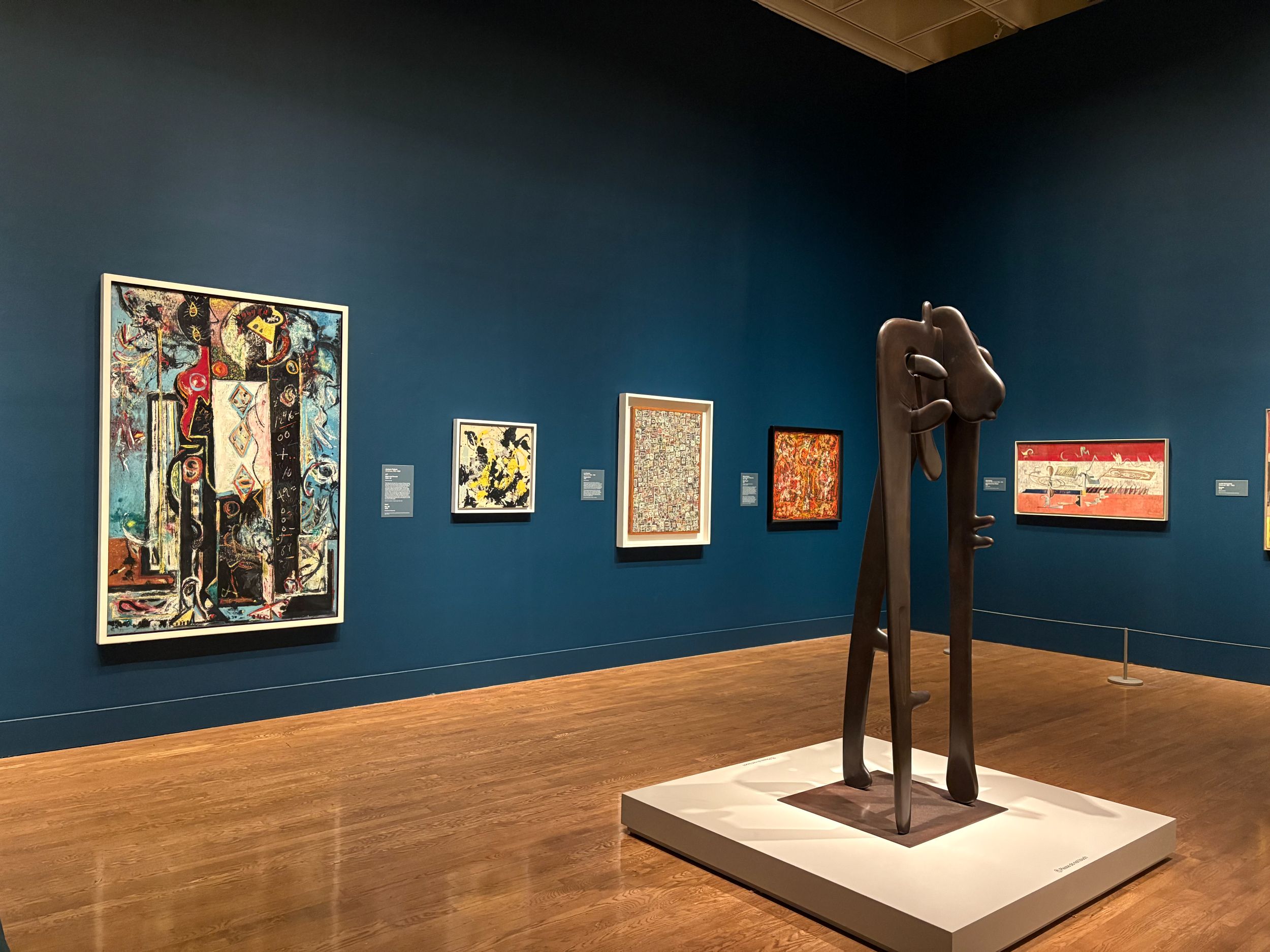Boom: Art and Design in the 1940s
Curated by: Jessica Todd Smith, Elisabeth Agro, Dilys Blum, Amanda N. Bock, and Lily F. Scott
Exhibition Schedule: Philadelphia Art Museum, April 12–September 1, 2025
Exhibition Catalogue: Alison McDonald and Jessica Todd Smith, eds., Boom: Art and Design in the 1940s, exh. cat. Philadelphia Museum of Art, 2025. 80 pp.; 91 color illus.; b/w illus. Paper: $25.00 (ISBN: 9780876333068)
Exhibitions drawn entirely from permanent collections rarely receive the same critical attention as blockbuster displays touting loaned masterworks, but Boom: Art and Design in the 1940s should be an exception. An impressive multimedia showcase of the Philadelphia Art Museum’s holdings, the exhibition offered an expansive and timely look at a decade in which artists held crisis and creativity in tension.1
Featuring more than 250 works from the museum’s permanent collection, Boom demonstrated how collaborative curatorial strategies and innovative object pairings can facilitate rich and nuanced storytelling across media. Led by Jessica Todd Smith, the curatorial team that imagined this display included resident specialists in contemporary craft and decorative arts, costumes and textiles, and photography. Although not strictly an exhibition of American art (works by artists of many nationalities, including Cuban, Russian, Japanese, and French were represented), Boom’s scope reflected the museum’s long-standing investment in artwork made in the United States. However, there was no shortage of variety: the cross-departmental collaboration required to mount this exhibition was evident not only in the curators’ emphasis on multifaceted, transnational stories but also in their wide-ranging selection of artistic media.
In the largest gallery, wartime posters were placed in dialogue with photographs of air raids, antifascist prints, scarves, and a bathing suit fashioned from a flexible acetate “escape and evade” map produced for soldiers during World War II. In works such as this distinctive bathing suit, novel materials and modes of making converge with the realities of wartime. Due to the rationing of supplies, ranging from fabric to metal requisitioned for military manufacture, working and thinking across media was a necessity in the 1940s. In addition to material lack, urgent political and social issues influenced artistic production, animating the work of artists like Florence Kent Hunter (1917–1989), whose print Jewish Refugees (c. 1938–39) pictures those fleeing the violent Nazi regime. Nearby, Leopoldo Méndez’s (1902–1969) Deportation to Death (1942), one of the earliest prints related to the concentration camps of the Holocaust, represents Mexican collaboration with European artists and lays bare the horrors of “deportation.”
Working within the boundaries of their collection, the curators championed a relatively diverse group of artists, including African American and Asian American artists who are too often marginalized in art-historical narratives. Such varied perspectives are essential to telling the many stories of this decade, rather than espousing a singular, authoritative narrative. Among the works that visitors encountered shortly after entering the exhibition were Claude Clark’s (1915–2001) painting Jam Session (1943) and Beauford Delaney’s (1901–1979 ) portrait of a young James Baldwin (1945). These pieces pulsate with vibrant colors and energetic potential, speaking to the perseverance of Black joy in a segregated America, whose promises of freedom and prosperity remained unevenly fulfilled. By placing Clark’s and Delaney’s works near a Norman Bel Geddes (1893–1958) radio designed to evoke the American flag and promote patriotism, curators juxtaposed complex, even unresolved, ideas about national pride and social justice (fig. 1). The work of Japanese American artists was necessarily represented in Boom, such as furniture pieces by George Nakashima (1905–1990), who was incarcerated at the Minidoka War Relocation Center in Idaho during World War II. Nakashima’s works were essential companions to propaganda posters and aspirational prints, such as a series by Hugo Gellert (1892–1985), in which people of various backgrounds and identities work together to fight fascism. Commendably, the curators did not shy away from addressing the real inequities and injustices that persisted on the home front and abroad, even as patriotic messaging dominated American mass media.

Although numerous works created before 1945 offered salient examples of innovation born of wartime stringency and advocacy, the sections of the exhibition that explored postwar consumerism and design also encouraged thinking across media and artistic backgrounds. In one gallery, prints by Bauhaus color theorist Josef Albers (1888–1976) shared space with two women’s suits by Irene Lentz (1901–1962) and the Bubble hanging lamps (ancestors of the famed IKEA fixtures) by George Nelson Associates of New York. Viewed together, the prints, garments, and lamps offered a masterclass in geometric design and midcentury silhouettes (fig. 2). Though formally compelling, the cross-media connections in Boom extended beyond the visual. In a nearby grouping, works by Charles (1907–1978) and Ray Eames (1912–1988) demonstrated how even the most iconic postwar designs reflect the social and material impacts of World War II. Having bested metal shortages by designing a wooden leg splint for injured soldiers in the early 1940s, the Eameses put their resourceful approach to work again in 1948, when they used fiberglass, a plastic developed for tactical gear, in the construction of the lightweight LAX armchair. Displayed together in a section of the exhibition titled “For Modern Living,” the leg splint and armchair suggest that trauma lived on in the bodies and furnishings of modern life. Multidimensional displays such as these function as powerful reminders that, for those living, working, and designing in the 1940s, the decade vibrated with the multifaceted meaning of the exhibition’s title. Alongside advances in technology and design, as well as a postwar population increase, the 1940s were marked by the deadly boom of atomic warfare and its aftershocks.

Conceptually layered and visually engaging, the display strategies deployed by the curators of this exhibition also posed a challenge to the restrictive hierarchies of artistic media that have long structured museum presentations and reinforced the worn-out division between high and low art. Though less prevalent in contemporary exhibitions and scholarship, these taxonomies continue to inform the organizational structures of museums, where curatorial departments cordoned off by culture or media make exhibitions like Boom challenging to realize. While the exhibition certainly includes established examples of so-called fine art by well-known modernists, such as Georgia O’Keeffe (1887–1986) and Joan Miró (1893–1983), these works are placed in conversation with objects that might previously have been relegated to “decorative” or “utilitarian” realms—or dismissed altogether. I was delighted to encounter, alongside the work of painters and sculptors, a plate (1941) and bowl (1946) by the ceramicist duo Gertrud (1908–1971) and Otto Natzler (1908–2007), a fiber abstraction (c. 1952) by Mariska Karasz (1898–1960), examples of streamlined industrial design (like the Petipoint iron that debuted in 1941), and the genre-defying Landscape Sculpture scarf (1947) by Barbara Hepworth (1903–1975). Wonderfully, works of various media stood on equal footing, shirking cliché arrangements that render industrial or decorative arts mere accessories.
However, the gallery focused on the emergence of Abstract Expressionism (fig. 3) could have benefited from a more creative approach to displaying canonical works of art. Although this section, titled “New Directions in Abstraction,” featured a striking collage by the queer Filipino American artist Alfonso Ossorio (1916–1990), the work hung on the edge of a wall where the movement’s more famous representative, Jackson Pollock (1912–1956), was centered. A large work by sculptor Isamu Noguchi (1904–1988) further anchored the gallery, but I found myself wondering what additional narratives of abstraction might have enhanced this section. What about the important contributions to abstraction made by Indigenous artists in the 1940s? Presumably, such works are not represented in the collection. Moreover, might there have been space to critically reconsider the role that Abstract Expressionism and its early champions played in the exportation of ideas about Americanness, masculinity, and freedom?2

An additional improvement to this generally thoughtful exhibition would have been the inclusion of relevant information about the history and scope of the Philadelphia Art Museum and its activities in the 1940s. All collections have strengths, weaknesses, and gaps, and the stories of how artworks come to live in museums are as important as what slips through the cracks. That the Philadelphia Art Museum’s inaugural curator of prints and drawings was hired in 1941 and that the museum’s first costume galleries opened in 1947 are among several fascinating details omitted from the gallery text.3 With this history close at hand, visitors might have better contextualized the exhibition’s strong display of garments, ranging from an American Red Cross volunteer uniform to haute couture by Christian Dior. Similarly, it might have been instructive to foreground which prints and posters were acquired by the nascent prints and drawings department in the 1940s and which thereafter. An essay discussing the museum’s collection and history during the 1940s can be found in a magazine-style booklet produced in conjunction with the exhibition, but the publication was not available in the galleries or a nearby gift shop at the time of my visit.
Nevertheless, Boom is an important case study for those interested in telling expansive, textured stories about American art and history. In a praiseworthy example of cross-departmental curation and imaginative thematic framing, the curators—perhaps taking cues from artists represented in the show—worked within limitations to create something exceptional. Additionally, as this review and the exhibition itself have gently suggested, it is worth lingering on the resonances between our time and the 1940s. The 1940s, not unlike the 2020s, were characterized by global catastrophe. In an era in which the lives and well-being of millions of people were under threat, in which war and hatred devastated people and culture, and in which authoritarian governments were on the rise, artists created through and because of adversity. As we mark eighty years since the end of World War II and find ourselves midway through another tumultuous decade, we might learn from these bold designers, artists, and makers.
In the exhibition’s final gallery, two clock faces peered out from adjacent walls. One, represented in Shomei Tomatsu’s (1930–2012) 1961 photograph of a watch that stopped the moment that the atomic bomb dropped on Nagasaki, is an uneasy yet thought-provoking companion to the other, a stylized 1947 Ball wall clock designed by Irving Harper (1916–2015). Representative of atomic-age horrors and innovations, these timepieces are also markers, witnesses, and observers. While contemplating these two very different clocks, it was difficult not to be reminded that the past is ever present.
Cite this article: Maggie North, review of Boom: Art and Design in the 1940s, Philadelphia Art Museum, Panorama: Journal of the Association of Historians of American Art 11, no. 2 (Fall 2025), https://doi.org/10.24926/24716839.20559.
Notes
- On October 8, 2025, the Philadelphia Museum of Art changed its name to the Philadelphia Art Museum. Although the institution’s former name was in use for the duration of Boom: Art and Design in the 1940s, this review makes use of the current name for the sake of clarity and consistency. ↵
- The dominant ideals, assumptions, and values that underscored the emergence of the Abstract Expressionist movement have, since the 1970s, been revisited and revised in scholarship and exhibitions. Among other theoretical lenses, social art history and feminism have reshaped the machismo narratives and emphasis on form championed by early critics, such as Clement Greenberg and Michael Fried. I would have liked to see some of these ideas in the wall text that introduced the “New Directions in Abstraction” section of Boom. See, for example, Max Kozloff, “American Painting During the Cold War,” Artforum 11, no. 9 (1973): 43–54; Ann Eden Gibson, Abstract Expressionism: Other Politics (Yale University Press, 1997); and Norman L. Kleeblatt and Stephen Brown, From the Margins: Lee Krasner/Norman Lewis, 1945–52 (Jewish Museum, 2014). ↵
- Jessica Todd Smith, “A Look at the 1940s,” in Boom: Art and Design in the 1940s, ed. Alison McDonald and Jessica Todd Smith (Philadelphia Museum of Art, 2025), 1–5. For additional information about the history of the collection, see “Our History,” Philadelphia Art Museum, accessed October 28, 2025, https://www.visitpham.org/our-history. ↵
About the Author(s): Maggie North is a graduate student in the History of Art department at Bryn Mawr College, Pennsylvania.

